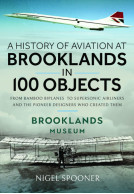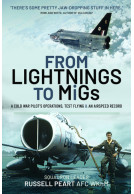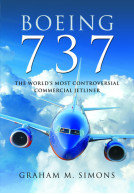A History of Aviation at Brooklands in 100 Objects (eBook)
Imprint: Air World
File Size: 72.0 MB (.epub)
Illustrations: 345 colour & black and white illustrations
ISBN: 9781526790927
Published: 30th June 2024
Book Launch
| Other formats available - Buy the Hardback and get the eBook for £1.99! | Price |
|---|---|
| A History of Aviation at Brooklands… Hardback Add to Basket | £29.99 |
At the dawn of the twentieth century mankind had not yet achieved powered flight. The main motive power then was provided by steam engines – heavy, dirty and inefficient. If one wanted to travel ‘over seas’ one had to travel on them. A journey from London to New York, by steam-driven train and ship, took more than 6 days.
By the time the same century drew to a close in December 1999, air travel was the normal choice for long journeys. Millions of people every day flew comfortably and safely in pressurised aluminium airliners propelled by simple, clean and efficient gas turbine engines. The same journey from London to New York could be achieved at supersonic speed in less than 6 hours.
For much of that century, many of the extraordinary developments that moved aviation from fragile wood and fabric biplanes to supersonic transports were achieved on 330 acres of low-lying former estate farmland in Surrey, England. The estate was called Brooklands. Those marshy acres were transformed from 1907 into the world’s first custom-built motor-racing circuit, then a rapidly developing aerodrome, and finally one of the country’s largest aircraft factories, employing tens of thousands of people.
Nearly 19,000 aircraft of many different types were built at Brooklands during nine decades of peace and war. By the 1980s however it was being eclipsed by larger manufacturing sites elsewhere, with longer runways and better communications links; its owner, by then called British Aerospace, finally closed the factory in 1989.
This book tells the history of those amazing developments through 100 of the key aircraft, engines, places and other objects that can still be seen, either in or near Brooklands Museum or in other locations around the country. It also highlights the stories of six designers whose inspiring creativity produced aircraft, engines and weapons ranging from Camel to Concorde, Fury to Harrier, Wellington to Viscount, Merlin to Olympus. Between them, Thomas Sopwith, Barnes Wallis, Rex Pierson, Sydney Camm, Stanley Hooker and George Edwards were responsible for much of what was designed, built and flown, not only at Brooklands but elsewhere too.
The book is arranged in successive historical episodes but the many links between the objects and the designers should allow readers to follow different paths if they so wish. It is not intended as a technical reference but rather to inspire the reader to seek out the objects and discover more about them.
*EDITOR'S PICK*
Pilot Magazine - February 2025
"Closely written and clearly very thoroughly researched, A History of Aviation at Brooklands will have broad appeal to aviation enthusiasts."
This book has just been launched and rather than trying to tell the full story the author has picked out 100 objects and told the story of each. Its a very clever way of writing a book and it encourages the reader to go out and find the objects to learn more about them. The book is not designed as a technical reference book but it is presented in a very readable, successive historic account of each object. It really is a refreshing change to see a book presented in such a way, whether you have a little or a lot of knowledge on the subject it will certainly give you a new look at things related to Brooklands.
UK Airfields - Facebook
This book is genuinely one of my favourite books that has been published recently, I keep picking it up and reading bits of it, going to find out more about the objects and its even inspired a return visit to Brooklands - and I have been several times already! The book talks about the race track right up to the modern day with the museum, engines, designers, places, propellers and even flying gloves are included in the 100 objects. Each chapter is paced with some great illustrations and anecdotes.
Reading the book there are so many objects linked in various ways, it is nice to be able to read about one object and then decide where to go next. Whichever way you look at it this book is a vey worth addition to any book shelf and I know its a book I will keep going back to. I would definitely recommend this book, if you have not ordered it already, put it on your wish list, you will not go wrong.
"...superbly crafted and thoroughly recommended..."
The Brooklands Bulletin
About Nigel Spooner
NIGEL SPOONER is a lifelong aviation enthusiast whose passion was kindled at the age of five by a flight in a Dragon Rapide biplane from London Airport (now Heathrow). His pilot then was a great-uncle who later taught him to fly at Biggin Hill during school holidays in the 1960s. Nigel was also fortunate to spend a week’s ‘work experience’ at the British Aircraft Corporation factory at Brooklands in Weybridge, observing VC10 airliners being built and witnessing the first flight of a Royal Air Force version. He inevitably yearned to become a commercial pilot, but poor eyesight thwarted that ambition and Nigel trained as an architect instead. A developing interest in the use of computers for design led to a second career in Information Technology, where a succession of international marketing roles involved clocking up several million miles travelling the world as a ‘professional passenger’! Happily, retirement has allowed Nigel more time to share his passion through serving as a volunteer steward at Brooklands Museum in Surrey. The idea for this book came from the desire to explain to museum visitors the extraordinary part that Brooklands, its people and its products have played in the development of British aviation.
















